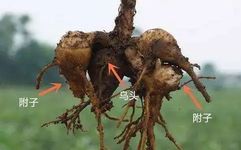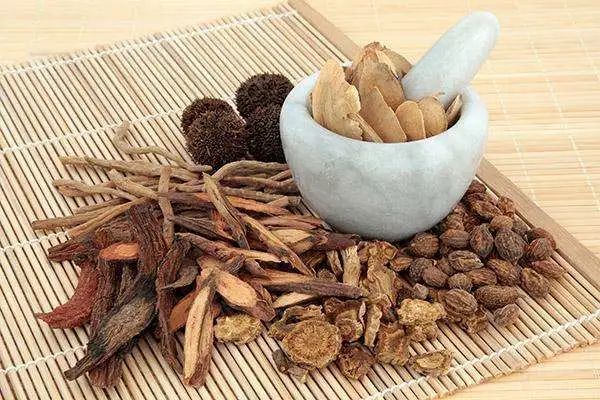
Aconite (Fu Zi) is a processed product derived from the lateral roots of the tuberous root of the Aconitum plant, which belongs to the Ranunculaceae family. The main root (mother root) is called Chuan Wu (Chuan Aconite), and both Chuan Wu and Fu Zi originate from the same plant.
Ancient scholars were already aware of the toxicity of Aconite. The Huai Nan Zi states: “Among all things in the world, none is more dangerous than the poison of Aconite.” The Guang Ya notes: “Aconite is the poison referred to as ‘Xi Du’. In the first year, it is called Zhi Zi, in the second year, Wu Wei, in the third year, Fu Zi, in the fourth year, Wu Tou, and in the fifth year, Tian Xiong.” However, Aconite is also a valuable medicinal herb; the Huai Nan Zi records that “Tian Xiong and Wu Wei are the most dangerous, but a skilled physician can save lives.”
The medicinal history of Aconite is long-standing, and its efficacy and toxicity have always been a focal point of research and debate among many medical scholars.
01
The Efficacy of Aconite
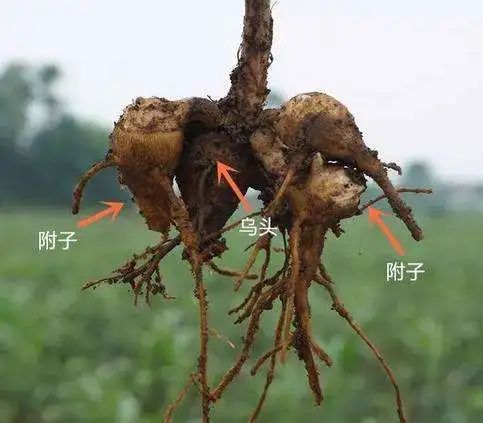
In the Ming Dynasty, physician Zhang Jingyue listed Aconite as one of the “Four Essentials of Medicine,” praising that “Ginseng and Shud Di (Rehmannia) are the good ministers of a peaceful world; Aconite and Dahuang (Rhubarb) are the good generals of a chaotic world.”
Aconite has the effects of restoring yang, assisting yang, dispelling cold, and alleviating pain.
-
Restoring Yang and Rescuing Reversal
Aconite is known as the “best medicine for restoring yang and rescuing reversal,” essential for treating yang deficiency, cold skin, and weak pulse. The Si Ni San (Four Reversal Decoction) in the Shang Han Lun is a classic formula for restoring yang and rescuing reversal, combining Aconite with Gan Jiang (Dried Ginger) and Zhi Gan Cao (Honey-fried Licorice) to enhance efficacy while reducing toxicity. It is primarily used to treat symptoms such as cold limbs, aversion to cold, fatigue, vomiting, diarrhea, profuse sweating, and weak pulse due to internal cold and weak yang. This formula has been used since its creation for treating critical conditions.
-
Assisting Yang and Supplementing Fire
Aconite is pungent and warm, capable of circulating through the twelve meridians, warming the body’s yang, assisting heart yang to open the vessels, warming spleen yang to dispel cold, and supplementing kidney yang to enhance fire, while also expelling surface cold. It can be used to treat insufficient heart yang, chest obstruction and pain, cold vomiting and diarrhea, abdominal cold pain, kidney yang deficiency, impotence, cold water swelling, and external invasion due to yang deficiency.
-
Dispelling Cold and Alleviating Pain
Aconite has a strong and aggressive nature, capable of warming and unblocking the meridians, expelling wind, cold, and dampness from the channels, and has a strong effect in dispelling cold and alleviating pain, making it suitable for treating pain due to wind, cold, and dampness obstruction.
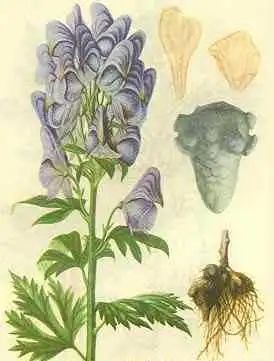
02
The Toxicity of Aconite
Aconite is toxic; the Book of Han records a case of “Aconite poisoning.” According to the Book of Han: Biographies of the Empresses, during the reign of Emperor Xuan of Han, General Huo Guang wanted his daughter to become empress, so he coerced the physician Chunyu Yan to harm Empress Xu after she gave birth. Chunyu Yan secretly mixed powdered Aconite into the medicine that Empress Xu was to take, and she quickly fell into a coma and died after taking the medicine.
The toxic components of Aconite include aconitine, with a dose of 0.2 mg of aconitine being sufficient to cause poisoning, and a lethal dose being 3-4 mg. Aconite poisoning can affect multiple systems, including the nervous, circulatory, and respiratory systems, presenting symptoms such as numbness of the lips and limbs, nausea, vomiting, palpitations, shortness of breath, agitation, and even coma, with occasional convulsions. In severe cases, it can lead to cardiac arrest and respiratory failure. Aconitine is particularly toxic to the heart, with ECG findings showing transient bradycardia, atrial and ventricular premature contractions, tachycardia, and non-paroxysmal ventricular tachycardia and ventricular fibrillation.
03
Detoxification Measures
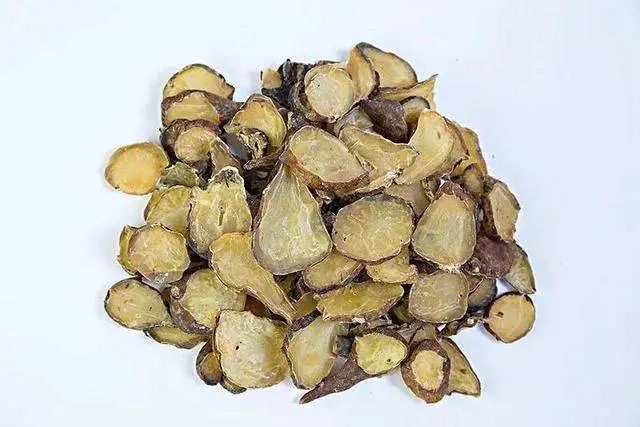
Ancient scholars were aware of the toxicity of Aconite, and the Shen Nong Ben Cao Jing classified Aconite as a lower-grade herb, highly toxic and unsuitable for long-term use. Throughout history, physicians have paid great attention to its toxicity and have attempted various measures to reduce its toxicity while pursuing optimal efficacy.
-
Processing to Reduce Toxicity
Raw Aconite is highly toxic and is rarely used clinically; most often, processed Aconite is used. The processing history of Aconite is long and complex, with physicians continuously exploring new processing methods over the ages.
The processing methods for Aconite first appeared in the Jin Kui Yao Lue: “All must be peeled, not chewed, and can be either processed or raw, with the skin removed.” This mentions the methods of “processing” and “peeling.” From the Wei and Jin Dynasties to the Tang Dynasty, methods such as roasting, stewing, and frying were added, along with water-fire co-processing with auxiliary materials like black beans, salt, vinegar, and ginger. In the Ming and Qing Dynasties, the processing technique focused on soaking and stewing, with direct heating methods being reduced, primarily using soaking followed by stewing or processing; the auxiliary materials also became simplified, often including licorice and black beans to mitigate toxicity, a practice that continues to this day. The Chinese Pharmacopoeia (2020 Edition) lists processed varieties of Aconite, including black shun slices, white Aconite slices, and light Aconite slices.
During the processing, the highly toxic diester aconitine is hydrolyzed into benzoyl monoester alkaloids, which are further hydrolyzed into alcohol amine-type alkaloids, thereby reducing toxicity.
-
Compatibility to Reduce Toxicity
Through reasonable compatibility, the toxicity and adverse reactions of Aconite can be significantly reduced. When combined with Gan Jiang and Gan Cao, the toxicity of Aconite can be lowered. The flavonoids in licorice can counteract the arrhythmias caused by aconitine. The main components of dried ginger are volatile oils and gingerols, which may have a restraining and resolving effect on aconitine, thus inhibiting the toxicity of Aconite. Studies have shown that Aconite combined with Dahuang, Huangqin, Huanglian, and Zhizi, all cold-natured herbs, have certain detoxifying effects; Aconite combined with Ren Shen (Ginseng), Huangqi (Astragalus), Fang Feng (Siler), and Yuan Zhi (Polygala) also has detoxifying effects.
-
Dosage and Preparation Methods
Aconite is a toxic herb, and excessive use may lead to poisoning. The Chinese Pharmacopoeia stipulates a dosage of 3-15 g for Aconite, but due to varying understandings and clinical experiences among physicians throughout history, there is controversy regarding its dosage range. If using beyond the conventional dosage, adjustments must be made based on the patient’s condition and response to ensure safe use.
Aconite is pungent, warm, and toxic; it must be decocted for a long time, especially when used in large doses. Modern research has also proven that prolonged decoction can reduce the toxicity of Aconite.
04
How to Avoid Poisoning
Cases of poisoning due to improper use of Aconite are not uncommon. The reasons often stem from self-medication, improper decoction, improper processing, excessive application, and inappropriate compatibility. Once poisoning symptoms appear, the medication should be stopped immediately; for mild reactions, inducing vomiting or gastric lavage can help eliminate the toxins. Treatment for Aconite poisoning primarily involves symptomatic treatment in Western medicine, but can also include the use of licorice and mung beans to enhance detoxification effects.
To avoid Aconite poisoning, attention should be paid to the following aspects:
-
Avoid self-purchasing and using Aconite; it must be used under the guidance of a physician after proper diagnosis;
-
Do not use raw Aconite for decoction; only processed Aconite should be used;
-
When using processed Aconite, start with a small amount and adjust the dosage based on the condition and response; large doses must be decocted for more than one hour.
References
Chinese Pharmacopoeia (2020 Edition)
Clinical Medication Guidelines of the Chinese Pharmacopoeia
—END—
Text: Zhang Pei
Proofreading: Clinical Pharmacy

